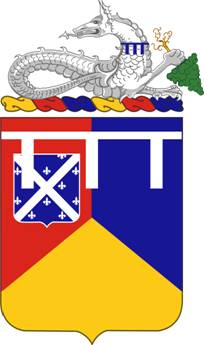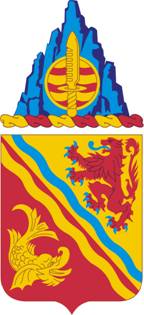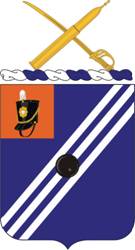
The 8th Infantry Regiment of the United States, also known as the "Fighting Eagles," is an infantry regiment in the United States Army. The 8th Infantry participated in the Mexican War, American Civil War, Philippine Insurrection, Moro Rebellion, World War I, World War II, Vietnam War, and Iraq Campaign.

The 66th Armor Regiment is the oldest armored unit in the United States Army, tracing its lineage to the 301st Tank Battalion which served with distinction soon after it was formed in the First World War; the 301st trained at Camp Meade, Maryland, where then-Cpt. Dwight D. Eisenhower was an instructor. It has often been rumored that the 301st, the parent unit of the 66th, was first commanded by Col. George S. Patton, but this appears not to have been the case; while Patton was the first officer assigned to the Tank Corps, and while the 301st Tank Battalion was the first unit formed, Patton went nearly immediately to France to train Americans attached to Allied commands. The 301st was the only American heavy tank battalion to have seen action in the war. After the war, the 301st transitioned in the Regular Army to become the 66th Infantry Regiment by way of the 16th Tank Battalion.
The 54th Infantry Regiment is a United States Army Regimental System parent regiment of the United States Army. It is represented in the active Army by the 2nd and 3rd Battalions, which conduct Infantry One Station Unit Training (OSUT) at Fort Moore, Georgia.

The 50th Infantry Regiment is a United States Army infantry regiment.

The 83rd Field Artillery Regiment is a regiment of the Field Artillery Branch of the United States Army.

The 33rd Armor Regiment was an armored regiment in the United States Army first formed in 1941. In 2005, the 33rd Armor was redesignated 33rd Cavalry Regiment. The 1st Squadron, 33rd Cavalry Regiment, a part of the 3rd Brigade Combat Team, 101st Airborne Division, carries on the lineage of 33rd Armor Regiment.

The 34th Armor Regiment is an armored regiment of the United States Army formed in 1941.

The 63rd Armor Regiment is an armored regiment of the United States Army formed in 1942.
The 67th Armored Regiment is an armored regiment in the United States Army. The regiment was first formed in 1929 in the Regular Army as the 2nd Tank Regiment (Heavy) and redesignated as the 67th Infantry Regiment (Medium Tanks) in 1932. It first became the 67th Armor in 1940. The regiment participated in World War I, World War II, Desert Storm/Desert Shield, Operation Iraqi Freedom, Operation Enduring Freedom, Operation Spartan Shield, Operation Inherent Resolve, Operation Resolute Support, and Operation Freedom's Sentinel.
The 3rd Field Artillery Regiment is a field artillery regiment of the United States Army, first formed in 1812, although regimental units trace their lineages as far back as 1794. Based on the service of these antecedents, the regiment claims battle honors for the War of 1812, the Seminole campaign, the Mexican War, the Civil War, the Spanish–American War, and the Philippine Insurrection. The regiment served with the 6th Division during World War I, with the 5th Division, 6th Division and 2d Cavalry Division between the world wars, and with the 9th Armored Division during and after World War II. Since 1961, the regiment has been a parent regiment under the Combat Arms Regimental System and the U.S. Army Regimental System, with regimental elements serving with the 1st, 6th, and 8th Infantry Divisions; 2nd and 3rd Armored Divisions; 1st Cavalry Division; 194th Armored Brigade; and various field artillery brigades and groups. Two regimental battalions are currently active: the 2nd Battalion in the 1st Armored Division and the 5th Battalion in the 17th Field Artillery Brigade

The 15th Field Artillery Regiment (FAR) is a field artillery regiment of the United States Army first formed in 1916. A parent regiment under the U.S. Army Regimental System, the 15th FAR currently has two active battalions: the 1st Battalion, 15th Field Artillery Regiment, is assigned to the 1st Brigade Combat Team, 2nd Infantry Division, while the 2nd Battalion, 15th Field Artillery Regiment, is assigned to the 2nd Brigade Combat Team, 10th Mountain Division.
The 16th Field Artillery Regiment is a field artillery regiment of the United States Army. The regiment served with the 4th Division in World War II and with the 4th and 8th Divisions between the World Wars. As the 16th Armored Field Artillery Battalion, it served with the 9th Armored Division during World War II, and with the 2nd Armored Division after the war. Designated a parent regiment under the Combat Arms Regimental system, and later the U.S. Army Regimental System, since 1957, regimental elements have served with the 1st, 2nd and 4th Armored Divisions; the 4th, 8th, and 81st Infantry Divisions; and the 1st Cavalry Division. Regimental elements have participated in combat in Vietnam, and in Operation Iraqi Freedom. The regiment currently has a single active battalion, the 3rd Battalion, 16th Field Artillery, assigned to the 2nd Brigade Combat Team, 1st Cavalry Division and stationed at Fort Cavazos, Texas.

The 37th Field Artillery Regiment is a field artillery regiment of the United States Army, and parent regiment under the U.S. Army Regimental System. The regiment was first constituted 5 July 1918 in the National Army. The regiment served with the 10th Division during World War I, and the 2nd Infantry Division during World War II. Elements of the regiment have served with the 2nd Infantry Division, 6th Infantry Division, 79th Infantry Division, and 172nd Infantry Brigade, among other units. Two battalions of the regiment are currently active, the 1st Battalion, 37th Field Artillery is the 155mm towed cannon battalion assigned to the 1st Stryker Brigade Combat Team, 2nd Infantry Division and the 6th Battalion, 37th Field Artillery is a Multiple Launch Rocket System battalion in the 210th Field Artillery Brigade.

The 76th Field Artillery Regiment is a field artillery regiment of the United States Army. First formed as a cavalry regiment in 1916, the regiment was converted to field artillery in 1917, and served in Europe during World War I with the 3rd Division and as a separate battalion during World War II, as well as in peacetime at Fort Knox, KY, and Fort Devens, MA. Since 1959, the regiment has been a parent regiment under the Combat Arms Regimental System and the U.S. Army Regimental System, with regimental elements serving with the 3rd Infantry Division in Germany and Operation Iraqi Freedom, with the 7th Infantry Division in Korea, and in the Army Reserve. No regimental elements are currently active.
The 94th Field Artillery was constituted in the Regular Army on 1 October 1933.

The 133rd Field Artillery Regiment is a parent field artillery regiment of the United States Army National Guard. It is currently represented in the Texas Army National Guard by the 1st, 3rd, and 4th Battalions.

The 84th Field Artillery Regiment is a field artillery regiment of the United States Army.

The 102nd Cavalry Regiment is a regiment of the United States Army first established in 1913 and which saw service in World War II.
The 114th Infantry Regiment is an Infantry regiment of the New Jersey Army National Guard.
The 118th Field Artillery Regiment is a field artillery regiment of the Georgia Army National Guard. The regiment's 1st Battalion is the cannon battalion assigned to the 48th Infantry Brigade Combat Team. It is one of several National Guard units with colonial roots and campaign credit for the War of 1812.














